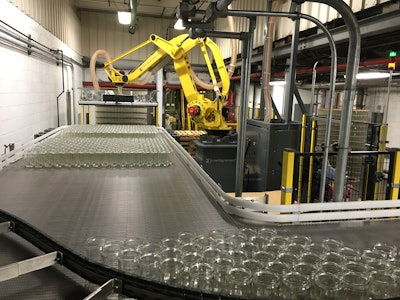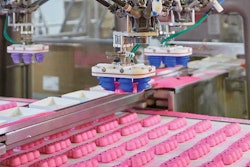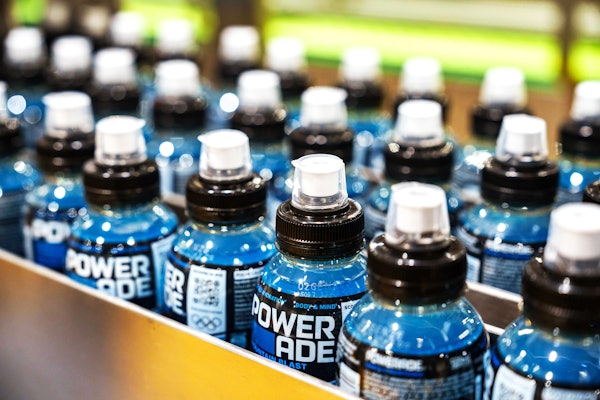
With annual sales of $8 billion, Campbell Soup Co. is among the largest food companies in the world. Likewise, its Napoleon, OH, plant is also among the largest—if not the largest—food manufacturing plants in the world as well. At nearly 2.5 million square feet, the plant is responsible for more than two-thirds of Campbell’s beverage volume and over a third of soup volume in North America. It’s ironic then, that one of the plant’s first robot applications was driven by a lack of space.
The issue was a low-level glass jar depalletizer for a sauce line that was shoehorned in a small space with a low ceiling. As Abhijit Choudhury, Project Engineer – Filling and Packaging at Campbell, explains, “With not much vertical elevation and not enough room anywhere around the machine, it was a very tight space. This made loading the pallets and unloading the glass jars very difficult.”
Very difficult and very inefficient as well. Choudhury estimates that up to 200 glass jars per pallet could break during the depalletizing process, resulting in significant line downtime—potentially up to an hour—as operators worked to ensure all the glass fragments were picked up.
One cause of the problem was the state in which glass containers are supplied. The jars, in 16- and 24-oz sizes for the sauce line, arrive at the Napoleon plant on pallets secured by bands. Each layer is separated by a tier sheet, and a wooden frame is situated on top. Despite the banding, the jars often shift during transportation, resulting in uneven layers and glass jars leaning toward the edges of the tier sheets.
But it was the combination of the uneven pallets with the low-level depalletizing technology that really created the inefficiencies. Says Choudhury, “With a low-level depalletizer, unless you have a camera-based gripper adjustment mechanism, it is extremely difficult to straighten the pallet. And then, because the machine holds the tier sheets at the corner, if the glass shifts, every layer where you grab the tier sheets may be different, so you end up knocking over a lot of the jars. And, sometimes, you are not even able to grab it. This makes it extremely difficult to sweep the jars onto a stationary platform as well.”
In looking for an alternative to replace the low-level machine, Campbell kept coming back to the issue of limited space. One solution, though, that met Campbell’s need for a repeatable, reliable system that could fit in tight quarters was robotics. In 2016/2017, Choudhury worked with Honeywell Intelligrated to install a robotic depalletizer featuring a Fanuc M410i/315 four-axis robot.
The beauty of the system, Choudhury relates, is the complexity of functions the robot can handle with ease, facilitated by three different end-of-arm tools designed by UniGripper by Tepro. At a speed of 2.5 layers/min, the robot picks a full layer of jars—up to 300 in all—from a pallet and places it on the infeed of the bottling line, removes the tier sheet or the pallet cover and places it in a segregated area, and then ultimately picks up the empty pallet and places it in another segregated area.
The depalletizing process begins when an operator loads multiple pallets onto a conveyor leading to the depalletizing cell. With the previous system, operators were reluctant to add more than one pallet at a time, because if glass breakage occurred with the lead pallet, they would have to back all of the pallets off the conveyor to remove the first one. “Since the reliability of the robot is so great, they can now put all pallets at one time on the conveyor,” confirms Choudhury.
The robot’s reliability also means that fewer operators are needed to run the line. With the low-level depalletizer, two people were assigned to the machine, with another on standby to clean up broken glass. With the robotic depalletizer, that number has been reduced to one, saving the plant a significant amount of money each year. The transition to the new system has also improved morale, making this a more desirable work area.
The most notable improvement, however, is in the line efficiency. As Choudhury explains, before Campbell installed the robotic depalletizer, the sauce line ran at about 54% efficiency, with approximately 56% downtime, 80% of which was caused solely by the depalletizer. “So obviously it was a huge area of improvement,” he says. “Now the depalletizer runs around 99.5 percent of the time, and the line is running at 80-percent or greater efficiency all the time. With just those 30-percent to 35-percent efficiency points gained, we’ve saved in the thousands.”
Together, the increased efficiency, reduced labor, and decrease in lost materials due to breakage served to justify the sizable investment in robot technology. Making the decision to invest significantly more than the cost of a traditional depalletizer was not an easy one for Campbell, but in this case, Choudhury says, it was the right one: “As an engineer, you have to make a choice as to whether an increased investment is really needed. In this case, we could justify that yes, it was needed for what we were trying to implement it for.”
Read the full article, "Packagers Realize ROI with Robotics," here.



























